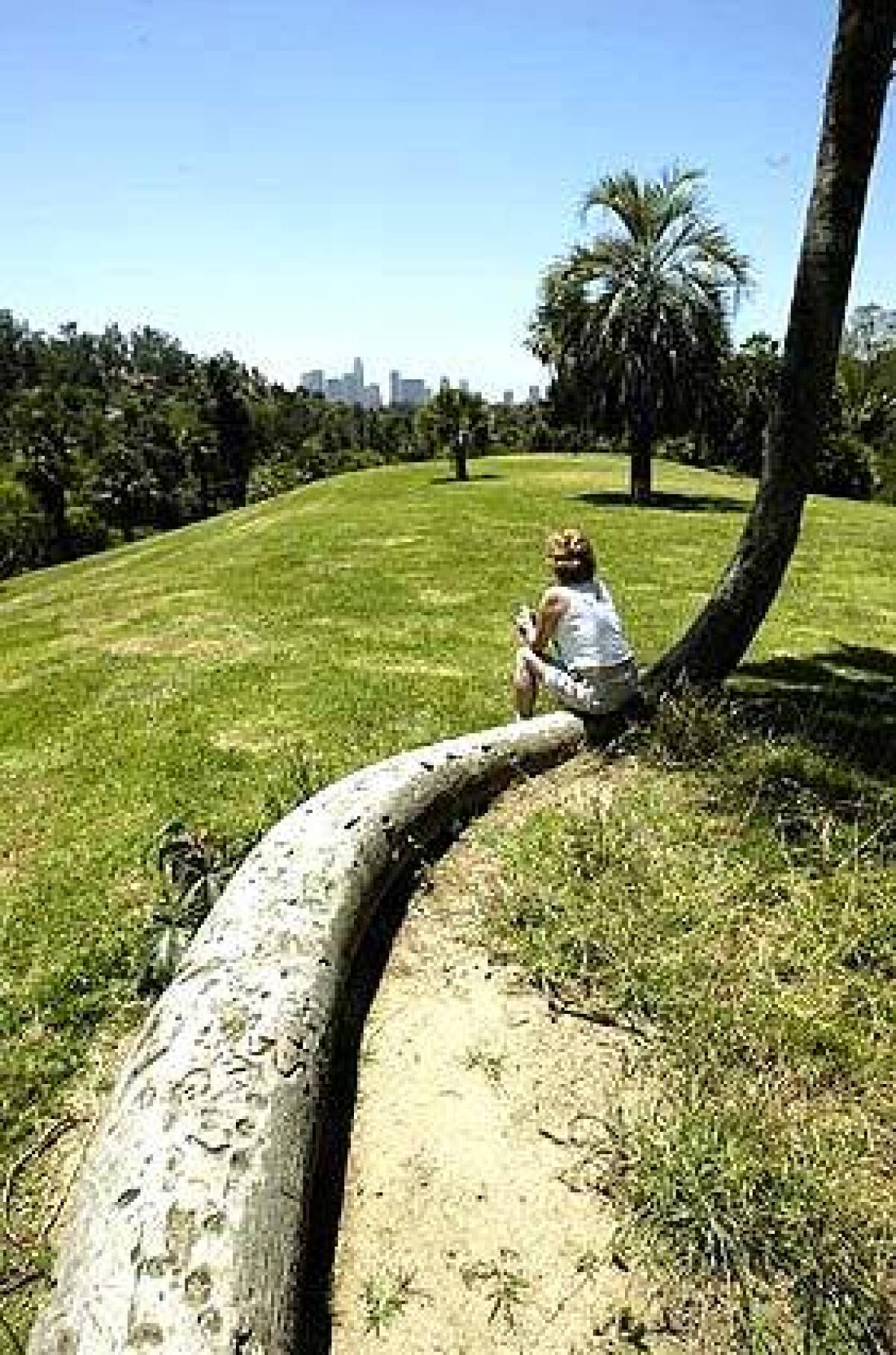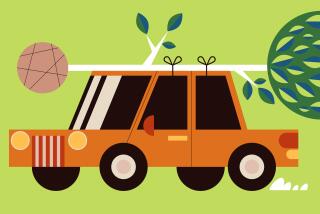Where roots run deep

If the wealth of a city can be measured by its urban forest, then Los Angeles is rich with countless arboreal gems.
One treasure lies just north of downtown, unnoticed by thousands who pass by it each day on their way to work or a Dodgers game: the century-old Chavez Ravine Arboretum, bordered by slopes of native toyon and walnut in Elysian Park. This living museum of trees is Southern California’s oldest arboretum, founded by the Los Angeles Horticultural Society in 1893.
“It’s a hidden jewel, a part of our heritage,” says Jon Kirk Mukri, recently appointed general manager of the city’s Department of Recreation and Parks. Few know the arboretum exists, west of Stadium Way near the Grace E. Simons Lodge. Even fewer walk among its remarkable trees, take in their grandeur or use it to gather ideas and inspiration for their own gardens.
Owing to their age and the horticultural savvy of their planters, many trees in the Chavez Ravine Arboretum are the largest, finest, first or only specimens of their kind in California. You can see the tallest Queensland kauri (Agathis robusta) in the continental U.S., a neck-bending 120 feet high; the first Cape chestnut (Calodendron capense) and perhaps the mightiest bo tree (Ficus religiosa, sometimes called a Bodhi tree) in the state; a bald cypress (Taxodium distichum var. nutans) of superlative form and fall color; and the Avenue of the Palms, a magnificent double row of Canary Island date palms (Phoenix canariensis) lining Stadium Way, between Academy Road and Scott Avenue.
The unusual and diverse collection of nearly 140 species from various continents and climate zones impresses botanist Jim Bauml of the Los Angeles County Arboretum and Botanic Garden in Arcadia. He notes how well the various trees have done in this region.
“Some trees are just enormous,” he says, citing the pair of flowering tipu trees (Tipuana tipu) that flank a narrow section of Elysian Park Drive and are in their full, apricot-colored glory this month. “Others are really large and healthy examples of some of the more unusual trees in Southern California.”
Bauml also notes the Moreton Bay chestnut (Castanospermum australe), with its large dark leaves and huge red and yellow flowers. There’s the Chinese cedar, or toon (Toona sinensis, sometimes called Cedrela toona), a towering beauty with airy arm-length masses of small ivory flowers, and unusual oaks such as Quercus cerris, the turkey oak. After seeing rare Indian rosewood (Dalbergia sissoo) thriving in Chavez Ravine, Bauml planted them at the Arcadia arboretum.
He points out Baphia chrysophylla, a small-scale South African species with pea-like blossoms. “I can’t think of any other place I’ve seen one,” he says. The gnarled specimen at Chavez Ravine is part of the arboretum’s original planting and still produces white blossoms and plenty of viable seed (but more about that later).
“It’s amazing what’s there and still healthy,” Bauml says.
Though records are scarce and sketchy, a 1920s inventory lists more than 50 species of trees, 40 of which are still standing, says Teresa Proscewicz, principal forester for Recreation and Parks. Judging by their stature, other mature trees such as the cork oak (Quercus suber), river birch (Betula nigra) and New Zealand Christmas tree (Metrosideros excelsa) were added in the 1950s.
Proscewicz’s office and the Citizens Committee to Save Elysian Park have been tracing the arboretum’s history, documenting the collection and ensuring its preservation. They educate the public and city workers — and plant trees annually.
That’s crucial for a park — the oldest and second largest in L.A. — that has faced adversity practically since its dedication in 1886. The Pasadena Freeway, Dodger Stadium and the park’s six-lane entry road have since dissected quiet canyons, destroyed thousands of trees and altered the topography, blocking natural springs and affecting microclimates.
During the committee’s 40-year history, it has warded off freeway expansion, oil drilling and a proposed convention center atop the Avenue of the Palms. It has worked to add 43 acres and sponsored the construction of children’s play areas. It spearheaded the 1972 planting of rare palms on Palm Hill and conducts annual memorial tree plantings throughout the park.
In 1993, to commemorate the arboretum’s centennial, 35 saplings were planted — replacements for heritage trees that had died and new species added for diversity, Proscewicz says. At that time, with support from the Southern California Horticultural Society, the department affixed metal tags to most trees that state botanical and common names, plant family and country of origin. A map and a list of 138 species are on the Chavez Ravine Arboretum website, https://www.laparks.org/dos/horticulture/chavez.htm (click on “Map” under the subheading “The Trees”).
“We’ve added monkey hand and firewheel trees, Catalina ironwood and giant sequoia,” says Proscewicz, “and catalpas that will shade a children’s play area. They flowered for the first time this spring.”
Scott Fajack, president of the citizens committee, worries about space, but Proscewicz isn’t concerned.
“There’s always room, “ she says. “There are spots in the lawn of the Grace E. Simons Lodge, and we lost a big coral near the parking lot last week.”
Proscewicz and former intern Jorge Ochoa have developed a list of trees to be added: new ones such as traveler’s palm, baobab, ornamental avocado and sausage tree, as well as replacements such as the young Queensland kauris that will continue a horticultural legacy as nature takes its course with older specimens.
Ochoa and Bauml have germinated seed from the 112-year-old baphia, the little tree with the pretty white flowers. Bauml has 40 seedlings.
“I’m looking forward to planting some in the L.A. County Arboretum’s African section and distributing them to other gardens in the area,” he says.
Ochoa has more than 500 seedlings, and Recreation and Parks general manager Mukri has plans for them. Propelled by new Mayor Antonio Villaraigosa’s pledge to “green up” L.A., Mukri wants to take the fledgling baphia and other seedlings started from Chavez Ravine Arboretum and plant them on the grounds of Los Angeles-area schools, “linking the past and the present,” he says, and preserving our horticultural heritage.
“We can’t stop the loss of open space,” Mukri says, “but there’s a time and a place for everything. We can be stewards of the environment and still meet the needs of the people.”
Lili Singer can be reached at [email protected].
*
(BEGIN TEXT OF INFOBOX)
Well-preserved stands that deliver
The historic Chavez Ravine Arboretum in Los Angeles’ Elysian Park is an excellent source of ideas and inspiration for home gardeners — and a reminder of the region’s horticultural heritage.
Getting there: The arboretum is on the park’s western edge, west of Stadium Way near the Grace E. Simons Lodge. Trees are spread across the north and south sides of Elysian Park Drive.
What to see: Almost 140 species, many with metal tags that state the botanical and common names, as well as country of origin.
More information: L.A. Department of Recreation and Parks, (213) 485-5054, https://www.laparks.org/dos/horticulture/chavez.htm .
Additional reading: Donald R. Hodel’s 1988 book “Exceptional Trees of Los Angeles” (California Arboretum Foundation).
More to Read
Sign up for The Wild
We’ll help you find the best places to hike, bike and run, as well as the perfect silent spots for meditation and yoga.
You may occasionally receive promotional content from the Los Angeles Times.










